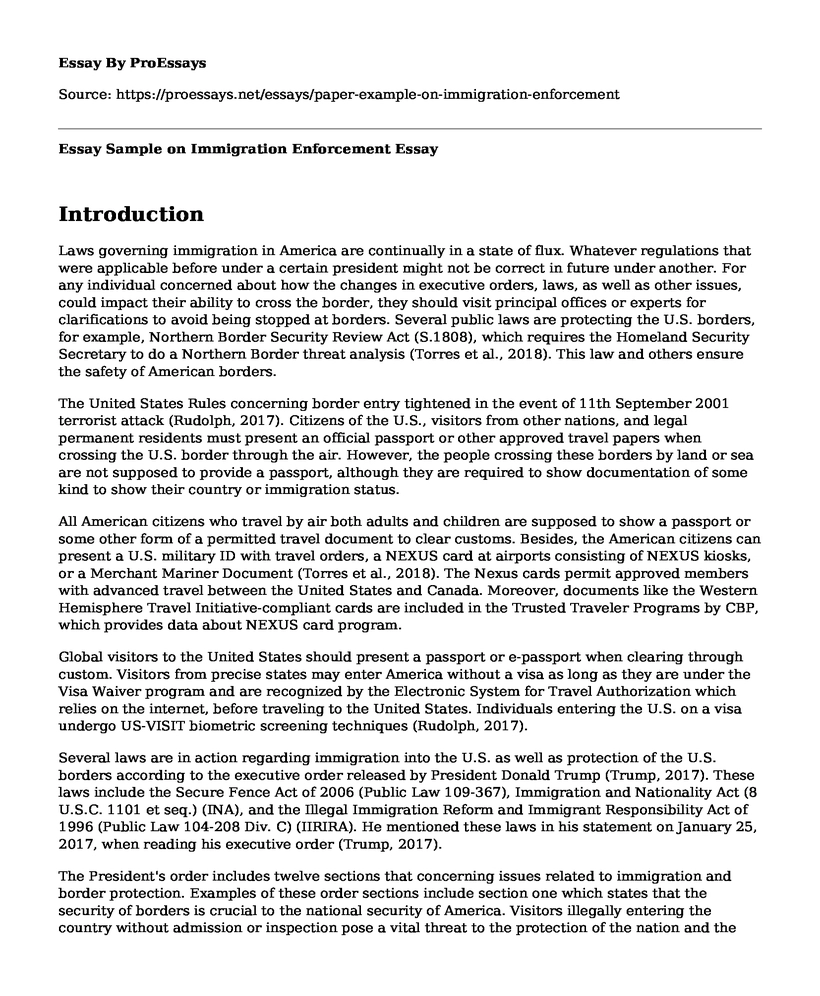Introduction
Laws governing immigration in America are continually in a state of flux. Whatever regulations that were applicable before under a certain president might not be correct in future under another. For any individual concerned about how the changes in executive orders, laws, as well as other issues, could impact their ability to cross the border, they should visit principal offices or experts for clarifications to avoid being stopped at borders. Several public laws are protecting the U.S. borders, for example, Northern Border Security Review Act (S.1808), which requires the Homeland Security Secretary to do a Northern Border threat analysis (Torres et al., 2018). This law and others ensure the safety of American borders.
The United States Rules concerning border entry tightened in the event of 11th September 2001 terrorist attack (Rudolph, 2017). Citizens of the U.S., visitors from other nations, and legal permanent residents must present an official passport or other approved travel papers when crossing the U.S. border through the air. However, the people crossing these borders by land or sea are not supposed to provide a passport, although they are required to show documentation of some kind to show their country or immigration status.
All American citizens who travel by air both adults and children are supposed to show a passport or some other form of a permitted travel document to clear customs. Besides, the American citizens can present a U.S. military ID with travel orders, a NEXUS card at airports consisting of NEXUS kiosks, or a Merchant Mariner Document (Torres et al., 2018). The Nexus cards permit approved members with advanced travel between the United States and Canada. Moreover, documents like the Western Hemisphere Travel Initiative-compliant cards are included in the Trusted Traveler Programs by CBP, which provides data about NEXUS card program.
Global visitors to the United States should present a passport or e-passport when clearing through custom. Visitors from precise states may enter America without a visa as long as they are under the Visa Waiver program and are recognized by the Electronic System for Travel Authorization which relies on the internet, before traveling to the United States. Individuals entering the U.S. on a visa undergo US-VISIT biometric screening techniques (Rudolph, 2017).
Several laws are in action regarding immigration into the U.S. as well as protection of the U.S. borders according to the executive order released by President Donald Trump (Trump, 2017). These laws include the Secure Fence Act of 2006 (Public Law 109-367), Immigration and Nationality Act (8 U.S.C. 1101 et seq.) (INA), and the Illegal Immigration Reform and Immigrant Responsibility Act of 1996 (Public Law 104-208 Div. C) (IIRIRA). He mentioned these laws in his statement on January 25, 2017, when reading his executive order (Trump, 2017).
The President's order includes twelve sections that concerning issues related to immigration and border protection. Examples of these order sections include section one which states that the security of borders is crucial to the national security of America. Visitors illegally entering the country without admission or inspection pose a vital threat to the protection of the nation and the safety of the public (Trump, 2017). Additionally, he gave the policy of the executive branch whose function was divided into four:
To safeguard the southern border of the U.S. through building a wall on the border, and additional monitoring and support provided by adequate personnel. This measure would prevent human and drug trafficking, immigration, and terrorism (Trump, 2017).
To arrest people held on suspicion of breaking state or federal law.
To speed up determinations of arrested individuals' assertions of eligibility to stay in the U.S.
Eject quickly people whose legal claims to remain in the US have been rejected according to the law.
Cooperate entirely with local as well as states law enforcement in endorsing partnership to implement federal immigration precedence, and state monitoring and detention programs that are reliable with federal law.
References
Rudolph, C. (2017). National security and immigration in the United States after 9/11.
Torres, S. A., Santiago, C. D., Walts, K. K., & Richards, M. H. (2018). Immigration policy, practices, and procedures: The impact on the mental health of Mexican and Central American youth and families. American Psychologist.
Trump, D. J. (2017). Executive Order 13767 of January 25, 2017: Border Security and Immigration Enforcement Improvements. Federal Register, 82(18), 8793-8797.
Cite this page
Essay Sample on Immigration Enforcement. (2022, Oct 17). Retrieved from https://proessays.net/essays/paper-example-on-immigration-enforcement
If you are the original author of this essay and no longer wish to have it published on the ProEssays website, please click below to request its removal:
- Violation of Physical and Mental Integrity of Persons Paper Example
- Essay Sample on Password Cracking Attacks
- Critical Essay on Michael Harrington's: The Other America
- Essay Sample on Abortion: The Debate on Reproductive Health and Rights
- Tackling Systemic Racism in Law Enforcement - Essay Sample
- Unemployment & Poverty: Sub-Sahara's Woes & Economic Fluctuations - Essay Sample
- Prison Overcrowding: A Life-Threatening Problem - Essay Sample







